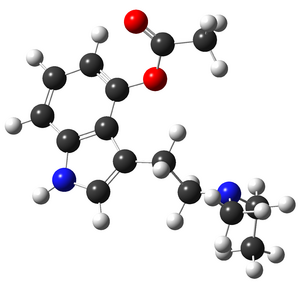This is an unofficial archive of PsychonautWiki as of 2025-08-11T15:14:44Z. Content on this page may be outdated, incomplete, or inaccurate. Please refer to the original page for the most up-to-date information.
UserWiki:Meisam
About me
Theoretical molecular chemist/physicist. Interested in finding stable geometries of molecules (mostly research chemicals) as a base for further research by other scientists.
FAQ
- What do I do here?
- I calculate the stable geometry of the molecules with Austin Model 1 (AM1) semiempirical method, and B3LYP density functional approximation and upload my results here.
- How accurate are these results?
- It is hard to say. But AM1 results are fairly good and B3LYP results are mostly accurate for geometry of organic molecules.
- Why the molecular bonds/shapes look different than the skeletal formula representation?
- Skeletal formula predictions for bonds/shapes are not accurate. My calculations find the geometry which have the least energy (therefore is the most stable one). These geometries may or may not be the same shape as their skeletal formula. Also, the proper method for finding the bond order is to perform a NBO analysis.
- Are these geometries valid for molecules in water/SBF/blood/urine, etc?
- No! All my calculations are done on isolated molecules (basically molecules in low pressure gas phase). The geometries depend on the environment and do change in presence of solvents. But based on the property you are interested in, they are generally a good approximation or a first guess.
- Are these geometries the most stable molecular configuration?
- There's no guarantee that these geometries are fully relaxed or are the most stable one. These molecules have a high degree of freedom and I have not enough time to check for all stable geometries and find the most stable one. I'm just searching for local energy minima on potential energy surface with Berny algorithm using GEDIIS in redundant internal coordinate. If a molecule have several stereoisomers, my calculations only finds one of them which is similar to my initial guess.
- I start my B3LYP calculations from the geometry obtained by AM1 method.
- Also, I do not check for existence of any imaginary vibrational frequencies.
- Can people use these geometries for their own research?
- Absolutely! Please read the terms of use for CC-BY-SA-4.0 license.
- Just keep in mind that B3LYP implementation of Gaussian (VWN functional part) may be different from the one you are going to use in other computational packages.
- What is the Z-matrix?
- A method for representing molecular geometries. You can use that for you research or to make a better image of molecules (if you want to!) More info here!
- Which software do I use?
- I use Gaussian 09 for calculations and GaussView 5 for visualization.
- Which basis set I am using?
- Unless stated otherwise:
- Polarized split-valence Pople-style Gaussian basis set 6-31G**
- What are my convergence criteria?
- Unless stated otherwise:
- Maximum Force: 0.000450
- RMS Force: 0.000300
- Maximum Displacement: 0.001800
- RMS Displacement: 0.001200
- Why I am not using more accurate method (larger basis set, other XC-functionals, solvents effect, multireference methods, etc.) for my calculations?
- More accurate calculations need lots of extra computation power which currently I don't have.
Useful references
- Development and use of quantum mechanical molecular models. 76. AM1: a new general purpose quantum mechanical molecular model, J. Am. Chem. Soc., 1985, 107 (13), pp 3902–3909 doi:10.1021/ja00299a024
- Comparison of SCC-DFTB and NDDO-Based Semiempirical Molecular Orbital Methods for Organic Molecules, J. Phys. Chem. A, 2006, 110 (50), pp 13551–13559 doi:10.1021/jp064544k
My works
